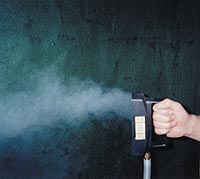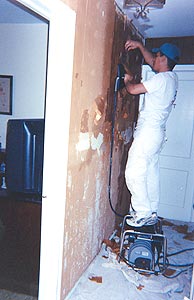
Wallpaper, Removing Wallpaper,
Surface Preparation
Effective surface preparation, appropriate products prevent wallcovering removal from becoming a sticky situation. Moisture must saturate the paste film for at least 20 minutes to fully loosen wallcovering. Any situation that prevents this process from occurring results in a very difficult removal.
By Jeff Woodard
means “off with the old and on with the new.” Whether planning to add a fresh coat of paint or a quality wallcovering, removing the old wallcovering is a procedure that can be pulled off with proper preparations and precautions.
According to Joe Parker, president of the National Guild of Professional Paperhangers and owner of Precision Painting & Wallcovering in Chadds Ford, Pa., “Nothing works better than scoring the wallcovering with a tool that makes tiny perforations. Another way would be to use very coarse sandpaper, then soak the wallpaper with a removal mixture.”
 “The most common way is to use a stripping chemical mixed in warm water,” says John Little, president of Atlanta’s NGPP chapter. “I use a garden type sprayer to apply to the wallcovering.” “The most common way is to use a stripping chemical mixed in warm water,” says John Little, president of Atlanta’s NGPP chapter. “I use a garden type sprayer to apply to the wallcovering.”
As a general rule, moisture must saturate the paste film for at least 20 minutes to fully loosen wallcovering, says Jim Turner, NGPP board member and owner of Regency Wallcraft in suburban Columbus, Ohio. “Any situation that prevents this process from occurring results in a very difficult removal,” says Turner. Such “situations” can be caused by wallpaper applied to bare drywall; to bare plaster; to low-grade builder’s flat paint; and to wallcovering primer or paint with a satin, semi- or gloss surface.
Using a warm-water spray usually loosens the adhesive, allowing easy removal of the wallcovering, says Parker. The only time warm or hot water will not accelerate the reactivation of pastes and adhesives, adds Turner, is on walls painted with poor quality latex paint. “Most failed attempts at wallcovering removal are due to insufficient moisture application. However, there has to be a balance — too much moisture will damage paint surfaces, woodwork and floorings,” says Turner. Having plenty of towels available to absorb excess solution is an excellent idea, as is covering electrical outlets, switch plates and telephone junctions with duct tape.
Most textiles and grass cloths are easily removed with moisture, says Parker. “They absorb the water readily, and generally are quite easy to remove from properly primed surfaces,” he says, adding that fabric-backed and full-sheet vinyls generally pull right off the walls. “In some cases, the paper backing left will come off after wetting. Mylars can be very difficult and require good scoring and wetting.”
For peelable vinyl, Niehaus recommends stripping off the face paper, wetting the backer paper and removing the vinyl with a broad knife. “I usually put a little of the remover solution into my hot water and wash the wall down with a 1⁄2-yard piece of nylon mesh netting to remove the adhesive that remains on the surface, then use a sponge and clean water to rinse the surface.
To remove grass cloth, Niehaus wets the surface with a removal solution and lets it sit a while. “It usually removes in a large piece. Then just wash and rinse the surface. Foils generally require a heavy-duty remover or steamer. “On plaster, I usually dry-strip it with a razor wallpaper-remover knife — but not on drywall,” says Niehaus. To remove string cloths, a spray of removal solution will make it easy to take the old wallcovering off in strips.
Used exclusively by professionals in Europe and more and more by professionals here in the USA, steamers have proven themselves a valuable tool for contractors. Removing wallcoverings with a steamer does not require the use of stripping gels or other chemicals, just plain water. They don’t require the type of masking and surface preparation typical with other methods of removal and they equate to about the same investment of time for stripping wallcovering. Using far less water than other methods of removal, steamers don’t run the risk of damaging surrounding furnishings or finishes. Steamers can also be used in conjunction with other methods of removal for particularly difficult materials.
According to Lou Ligeri, NGPP member and owner of Wallpaper Removing Specialists in New York City, steamers are useful if not always the most expedient way to remove wallcovering. “Steam removal is a must for paper on raw sheetrock, on border adhesive, and vinyl over vinyl. Everyone should have a steamer, although we only use ours about once a month,” says Ligeri.
Using a Hudson sprayer to pre-soak the wall with remover can greatly accelerate the steaming process, notes Turner. But caution is crucial. “In the hands of the unskilled, steamers can rapidly disintegrate underlying latex paint coatings with their heat and moisture, leading to excessive drywall damage,” Turner says, adding that a vinegar-water mix treatment can help neutralize the pH of plaster that is too alkaline in certain situations.
Gel can be slower and less effective than the standard stripping solutions mixed in water, but are especially useful when adjacent areas must be kept dry, says Little. Gels remain wet longer and are regarded as good for the do-it-yourself market because they do not drip and are user-friendly for the homeowner. Niehaus notes that gels are excellent on dried adhesives such as clay to keep them wet while adhesive is being removed from the surface.
“Roman’s Adhesive makes an excellent (liquid) stripper called Strip, and Zinsser makes a product called Dif,” says Parker. “Both make gel products; Zinsser’s is called Dif Gel and Roman’s is called Strip Plus.” Parker says he prefers the liquid solution, which is diluted with water.
The issue of hanging new wallcovering over existing wallcovering draws varied opinions. Parker says that if existing wallcovering is strongly bonded to the wall and its removal may damage the drywall, “a good primer over the existing wallcovering usually works fine. Sometimes it is necessary to lightly sand the seams so they are not visible.”
Niehaus and Turner see it differently. “I do not like to hang paper over any previous wallcovering,” says Niehaus. “I will not hang over other paper without getting a waiver signed first.” Adds Turner, “Examining the surface prior to installation, all may look well. After the new wallcovering has dried down, it may show underlying blisters, surface imperfections and lapped seams.”
Wallcovering used in commercial buildings usually must meet smoke- and flame-spread specifications, says Turner. “Installing an additional layer of wallcovering may void its rating and expose you to unwanted liability,” he says.
Whether painting or hanging new wallcovering, adequate preparation of the surface — including removal of old, dried adhesive — is crucial. “Painting over old wallcovering adhesive is an invitation to disaster,” says Turner. “Latex paint reactivates the paste, causing it to swell. If back rolled, the paint will release from the wet paste only to be deposited somewhere else on the wall.”
Turner suggests washing, rinsing and applying a high-quality primer — alkyd, shellac or acrylic-based — and top coat. He adds that failure to heed manufacturer installation instructions to remove old adhesive may void the product warranty.
Parker notes that humidity will cause paint applied over dried-over adhesive to have an “onion skin” type of flaking. “Also, painting over the adhesive will give the walls an unfinished look,” he says. Parker recommends using a Scotch pad-type of applicator or 8-inch taping knife to remove old adhesive.
Several latex primers have been developed specifically for repairing torn drywall. The Scotch Paint Corporation in Gardena, Calif., was the first to market such a penetrating drywall sealer, says Turner, citing Draw Tite as a “no run” sealer available in clear or pigmented form. Zinsser has a drywall-sealing product, Guardz, while Roman Adhesive makes Liquid Drywall. Both dry clear, says Turner. “After sealing damaged drywall, it can be repaired with a lightweight or standard patching compound,” adds Turner.
Regardless of the removal technique used, delivery of moisture to the underlying paste surface is the key to clean, effective removal of wallcovering. All removal is made easier when walls are properly prepared with a suitable wallcovering primer.

|

